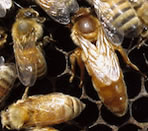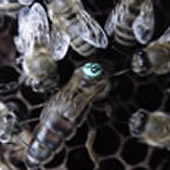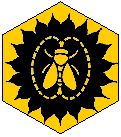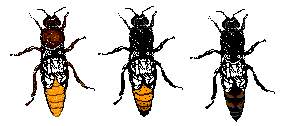Cordovans: Bees of a different color
Cordovan Italian | Italian | Carniolan |
I like to think of inspecting a hive as similar to reading a book. From first glance at flight activity at the hive entrance or signs of telltale debris, to the heft of the super and the brood nest inspection, the careful observer gathers useful information. Such observations reveal the bees' past history, their present state of health, and their prospects for the future.
Another source of information useful for tracking the genetic makeup of a colony, is the color of the queen, workers and drones. Most beekeepers are aware of the two basic body colors of bees, yellow and black. But there is another color variation that has long been used by bee researchers and is now becoming popular with queen breeders and their customers. This variation is called cordovan (also known by names such as red headed and ultra yellow)
This is a remarkably beautiful bee with some very practical advantages for the beekeeper.This color trait changes all the normally black body parts of the bee, like the head, thorax and tip of the abdomen, to a distinctive reddish brown color. All three castes of bees are affected. The queen's abdomen shows up yellow to the very tip, whereas the workers and drones have brown bands which would normally be black. This eye-catching color variation will save the queen hunter much time and frustration. Consider it a genetic "mark" like a dab of paint on the thorax, but one which cannot wear off. From personal experience, I find about 25% increase in my queen finding efficiency.
In these times of Africanized bee awareness, known parentage of your bees is more important than in the past. Unlike the ordinary yellow and black bees, cordovan color is controlled by a single recessive gene which will breed true only through controlled breeding, either artificial (instrumental) insemination or isolated mating areas. A quick look at the bees at the entrance will let you know if your cordovan queen has been replaced by swarming or supersedure. If the color of your bees reverts back to the ordinary color, you know the queen has been replaced. Another interesting effect is that you can recognize your bees working in the field, always a satisfying sight.
The cordovan color variation does not constitute a different race and is not known to be inherently linked with any other physical characteristic or behavior. In fact, any stock can be transformed to cordovan color in two generations of a cross and backcross to cordovan drones. For the queen breeder, this allows him to link selection efforts (e.g. honey production, disease resistance, gentleness) to the color trait, or in effect color code his breeding stock.
The effectiveness of the natural mating area can be assessed simply by observing the percentage of cordovan workers in the hives. This quantity corresponds to the percentage of cordovan drones mated with a cordovan queen.The single recessive gene that determines the cordovan color, works on the same principle that blue and brown eye color operates in people. Every person has a pair of genes that determine their eye color, one from each parent. Since the brown color is dominant over the blue, if either parent contributes a brown gene, their child's eyes will be brown. Only if both parents contribute the recessive blue genes will their child's eyes be blue. It is possible for two brown eyed parents to have a blue eyed child, but only if they are both carriers of blue genes. Similarly, in bees, only if the queen and a drone she mated with both contribute cordovan genes, will the workers or queens be cordovan. Drones are hatched from unfertilized eggs so they will always be cordovan, if laid by a cordovan queen, since she is the only parent
. Genetics of cordovan color
. Genetics of cordovan color

.For decades, bee researchers have utilized this cordovan color variation in ingenious experiments to decipher the genetics, mating behavior and other aspects of the honeybee. Today, in a world where information is as valuable as time or money, it is now possible for every beekeeper to use the information contained in the color of a bee to his own best advantage. These queens are instrumentally inseminated, and are suitable for queen rearing, research and production hives. Every queen is marked with a numbered disk and has one wing clipped. All of our queens are guaranteed to be fertile, healthy, and to arrive alive.
These queens are instrumentally inseminated, and are suitable for queen rearing, research and production hives. Every queen is marked with a numbered disk and has one wing clipped. All of our queens are guaranteed to be fertile, healthy, and to arrive alive.
 These queens are instrumentally inseminated, and are suitable for queen rearing, research and production hives. Every queen is marked with a numbered disk and has one wing clipped. All of our queens are guaranteed to be fertile, healthy, and to arrive alive.
These queens are instrumentally inseminated, and are suitable for queen rearing, research and production hives. Every queen is marked with a numbered disk and has one wing clipped. All of our queens are guaranteed to be fertile, healthy, and to arrive alive. 
No comments:
Post a Comment